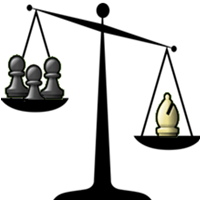
Imbalanced Forces, Part 1
A material imbalance in the endgame provides an unusual type of play. Here we watch the spectacle of pieces, each with different capabilities, fighting, trying to change the terrain to their own advantage. It is like two knights on horseback fighting five archers at close range, or a handful of Samurai taking on one armored, elephant-riding ninja.
I noticed the endgame from the Aronin-Borisenko game in an old copy of the 18th Soviet Championship tournament book. Here we'll watch a piece fight against three pawns and we'll cover a few instructive points. But while looking this up, I came across another game between the same two players - this time Borisenko-Aronin, played the following year in Lviv. This contest was even more interesting, and illustrates the complex fight that can be had between two minor pieces and a rook. We'll cover that game next week! Please note that Lev Aronin has a very similar name to the modern-day grandmaster Levon Aronian, but they are not the same person! Let us first look at the endgame from the first game:
An important point to note was that this game took place in the last round and, had Aronin won it, he would have tied for first place in the 1950 USSR championship.

The earlier part of the game was a nervous battle, with Aronin making a dubious piece sacrifice to avoid the prospect of (at maximum) a forced draw. A time scramble ensued, and numerous mistakes were made. We'll begin following the game at move 37.
White only has two pawns for the piece, but is going to get one back on e6 or a6. Black stood better earlier in the game, but now it is entirely unclear. The time scramble is ongoing, and I assume the time control was at move forty.
The unusual fortress reached in the variation to Black's 73rd move deserves a diagram:
In this endgame we have seen several methods employed in the fight between pawns and pieces: the blockade, fortresses, the sacrifice for a breakthrough. We have also seen some valuable practical methods. Observe, for instance, Aronin's patient and pointless maneuvering for twenty moves, wearing down his opponent mentally and physically - possibly causing a second bout of time pressure - nearly allowing him to win the game. Also note the psychology behind Borisenko's mistake of twice giving an unnecessary check.
Next week we will look at the fascinating game which took place between the same two players a year later, with a complex and tactical battle between two minor pieces and a rook, an often misunderstood material balance.
RELATED STUDY MATERIAL
- Read GM Bryan Smith's Sicilian Series starting with Sicilian Endgames: The Exchange Down;
- Watch this piece for pawns trade in GM Roman Dzindzichashvili's Roman's Novelty Shop: French Defense - Part 2;
- Pit your pawns against pieces in Chess Mentor;
- Dazzle your opponent after spending time in our Tactics Trainer;
- Looking for articles with deeper analysis? Preview our magazine: The Master's Bulletin.






